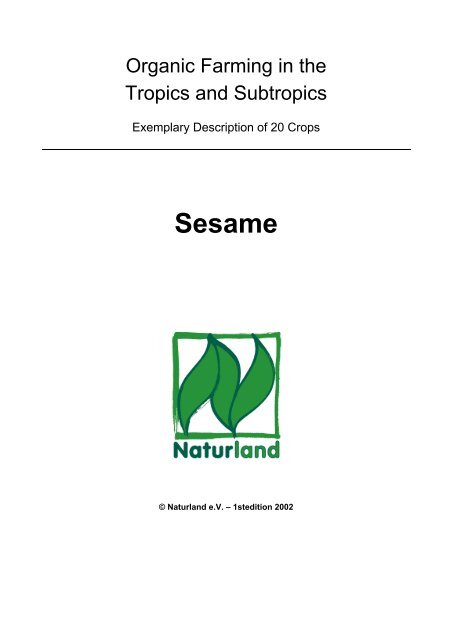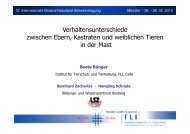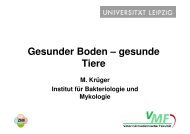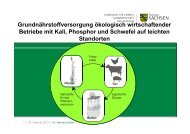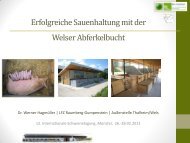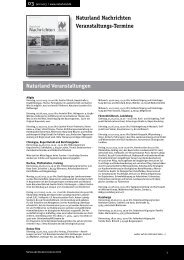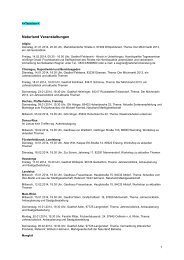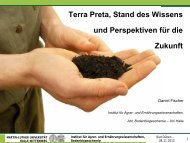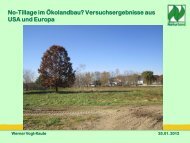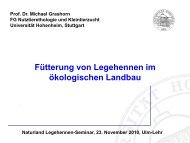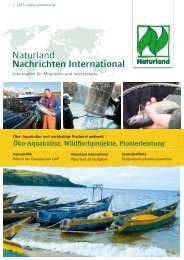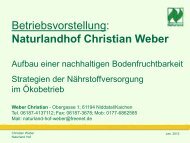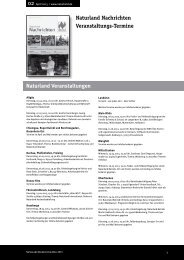Organic Farming in the Tropics and Subtropics: Sesame - Naturland
Organic Farming in the Tropics and Subtropics: Sesame - Naturland
Organic Farming in the Tropics and Subtropics: Sesame - Naturland
Create successful ePaper yourself
Turn your PDF publications into a flip-book with our unique Google optimized e-Paper software.
<strong>Organic</strong> <strong>Farm<strong>in</strong>g</strong> <strong>in</strong> <strong>the</strong><br />
<strong>Tropics</strong> <strong>and</strong> <strong>Subtropics</strong><br />
Exemplary Description of 20 Crops<br />
<strong>Sesame</strong><br />
© Naturl<strong>and</strong> e.V. – 1stedition 2002
These cultivation guidel<strong>in</strong>es have been published by Naturl<strong>and</strong> e.V. with <strong>the</strong> k<strong>in</strong>d support of <strong>the</strong><br />
Deutsche Gesellschaft für Technische Zusammenarbeit mbH (GTZ, German Agency for Technical<br />
Cooperation) f<strong>in</strong>anced by <strong>the</strong> Bundesm<strong>in</strong>isterium für Wirtschaftliche Zusammenarbeit (BMZ,<br />
Federal M<strong>in</strong>istry for Development Cooperation). The cultivation recommendations at h<strong>and</strong> for 20<br />
crops of <strong>the</strong> tropics <strong>and</strong> subtropics be<strong>in</strong>g of significant importance for <strong>the</strong> world economy were<br />
written by various authors.<br />
Naturl<strong>and</strong> would like mention <strong>the</strong> follow<strong>in</strong>g authors <strong>and</strong> thank <strong>the</strong>m for <strong>the</strong>ir contributions:<br />
Franz Augstburger, Jörn Berger, Udo Censkowsky,<br />
Petra Heid, Joachim Milz, Christ<strong>in</strong>e Streit.<br />
The cultivation guidel<strong>in</strong>es are available <strong>in</strong> English, Spanish <strong>and</strong> German for <strong>the</strong> follow<strong>in</strong>g crops:<br />
banana, brazil nut, cashew nut, cocoa, coconut, coffee,<br />
cotton, hibiscus, macadamia, mango, papaya, peanut,<br />
pepper, p<strong>in</strong>eapple, sugar cane, sesame, tea, vanilla.<br />
The cultivation guidel<strong>in</strong>es for Bananas, Mangoes, P<strong>in</strong>eapples <strong>and</strong> Pepper were revised <strong>in</strong> 2001 for<br />
<strong>the</strong> United Nations Conference on Trade <strong>and</strong> Development (UNCTAD) by Udo Censkowsky <strong>and</strong><br />
Friederike Höngen.<br />
In 2002 two more guidel<strong>in</strong>es, for rice <strong>and</strong> date palms, were published <strong>in</strong> English.<br />
All <strong>the</strong> authors emphasize, that <strong>the</strong> cultivation recommendations at h<strong>and</strong> can just provide general<br />
<strong>in</strong>formation. They do not substitute technical assistance to <strong>the</strong> farmers with regard to <strong>the</strong> location.<br />
All <strong>in</strong>dications, data <strong>and</strong> results of this cultivation guidel<strong>in</strong>es have been compiled <strong>and</strong> crosschecked<br />
most carefully by <strong>the</strong> authors. Yet mistakes with regard to <strong>the</strong> contents cannot be<br />
precluded. The <strong>in</strong>dicated legal regulations are based on <strong>the</strong> state of <strong>the</strong> year 1999 <strong>and</strong> are subject<br />
to alterations <strong>in</strong> future. Consequently all <strong>in</strong>formation has to be given <strong>in</strong> exclusion of any obligation<br />
or guarantee by Naturl<strong>and</strong> e.V. or <strong>the</strong> authors. Both Naturl<strong>and</strong> e.V. <strong>and</strong> authors <strong>the</strong>refore do not<br />
accept any responsibility or liability.<br />
Fur<strong>the</strong>rmore <strong>the</strong> authors k<strong>in</strong>dly call upon for critical remarks, additions <strong>and</strong> o<strong>the</strong>r important<br />
<strong>in</strong>formation to be forwarded to <strong>the</strong> address below. The cultivation guidel<strong>in</strong>es will be updated<br />
regularly by Naturl<strong>and</strong> e.V.<br />
Naturl<strong>and</strong> e.V.<br />
Kle<strong>in</strong>haderner Weg 1<br />
82166 Gräfelf<strong>in</strong>g<br />
Germany<br />
phone: +49 - (0)89 - 898082-0<br />
fax: +49 - (0)89 - 898082-90<br />
e-mail: naturl<strong>and</strong>@naturl<strong>and</strong>.de<br />
website: www.naturl<strong>and</strong>.de<br />
We pass our gratitude to Peter Brul of Agro Eco for his helpful comments on <strong>the</strong> manuscript. Our<br />
best thanks are also devoted to all supporters of this publication, <strong>in</strong> particular Mrs Sybille<br />
Groschupf who cleaned up <strong>the</strong> text from errors <strong>in</strong> strenuous detail work <strong>and</strong> did <strong>the</strong> attractive<br />
layout.
II Special section: <strong>Organic</strong> Cultivation of <strong>Sesame</strong><br />
Naturl<strong>and</strong> e.V. – 1 st edition 2000<br />
Index<br />
1. Introduction ................................................................................................ 1<br />
1.1. Botany ......................................................................................................... 1<br />
1.2. Varieties <strong>and</strong> produc<strong>in</strong>g countries ........................................................... 1<br />
1.3. Uses <strong>and</strong> contents ..................................................................................... 2<br />
2. Aspects of plant cultivation ...................................................................... 3<br />
2.1. Site requirements....................................................................................... 3<br />
2.1.1. Climate requirements ................................................................................... 3<br />
2.1.2. Soil requirements ........................................................................................ 3<br />
2.1.3. O<strong>the</strong>r factors ................................................................................................ 4<br />
2.2. Seeds........................................................................................................... 4<br />
2.2.1. Second generation <strong>and</strong> seed preparation .................................................... 4<br />
2.3. Sow<strong>in</strong>g methods ........................................................................................ 4<br />
2.3.1. Seedbed preparation.................................................................................... 4<br />
2.3.2. Sow<strong>in</strong>g ......................................................................................................... 5<br />
2.3.1. S<strong>in</strong>gl<strong>in</strong>g ........................................................................................................ 5<br />
2.4. Diversification strategies .......................................................................... 6<br />
2.4.1. Crop rotation ................................................................................................ 6<br />
2.4.2. Mixed crops.................................................................................................. 7<br />
2.4.3. Bee-keep<strong>in</strong>g ................................................................................................. 7<br />
2.5. Supply<strong>in</strong>g nutrients <strong>and</strong> organic fertilization management................... 7<br />
2.5.1. Nutrient requirements................................................................................... 7<br />
2.5.2. <strong>Organic</strong> fertilisers ......................................................................................... 8<br />
2.5.3. Leaf fertilisers............................................................................................... 9<br />
2.5.4. Green manure .............................................................................................. 9<br />
2.6. Biological methods of plant protection ................................................. 10<br />
2.6.1. Diseases <strong>and</strong> methods of prevention <strong>and</strong> combat<strong>in</strong>g <strong>the</strong>m ....................... 10<br />
2.6.2. Pests <strong>and</strong> methods of combat<strong>in</strong>g <strong>the</strong>m...................................................... 12<br />
2.7. Crop cultivation <strong>and</strong> ma<strong>in</strong>tenance ......................................................... 15<br />
2.7.1. Crop monitor<strong>in</strong>g.......................................................................................... 15<br />
2.7.2. Weed management.................................................................................... 15<br />
2.8. Harvest<strong>in</strong>g <strong>and</strong> post harvest treatment ................................................. 16
II Special section: <strong>Organic</strong> Cultivation of <strong>Sesame</strong><br />
2.8.1. Time of harvest .......................................................................................... 16<br />
2.8.2. Dry<strong>in</strong>g <strong>in</strong> <strong>the</strong> field/thresh<strong>in</strong>g........................................................................ 17<br />
2.8.3. Dry<strong>in</strong>g <strong>and</strong> clean<strong>in</strong>g seeds......................................................................... 17<br />
3. Product specifications............................................................................. 17<br />
3.1. Process<strong>in</strong>g................................................................................................ 18<br />
3.1.1. Post-harvest h<strong>and</strong>l<strong>in</strong>g - storage ................................................................. 18<br />
3.1.2. Quality requirements .................................................................................. 18<br />
3.1.3. Packag<strong>in</strong>g <strong>and</strong> storage .............................................................................. 19<br />
Appendix................................................................................................................. 22<br />
Naturl<strong>and</strong> e.V. – 1 st edition 2000
II Special section: <strong>Organic</strong> Cultivation of <strong>Sesame</strong><br />
1. Introduction<br />
1.1. Botany<br />
<strong>Organic</strong> cultivation of sesame<br />
<strong>Sesame</strong> e sesame um <strong>in</strong>dicum L. (S. orientale L.) belongs to <strong>the</strong> double-cotyledon<br />
pedaliaceae family. It is an annual plant, which grows ei<strong>the</strong>r bush-like or upright,<br />
depend<strong>in</strong>g on variety, to a height of 1-2 m. Its vegetation period is generally around<br />
3-4 months. The oil plant has been grown s<strong>in</strong>ce <strong>the</strong> beg<strong>in</strong>n<strong>in</strong>g of arable cultivation,<br />
<strong>and</strong> orig<strong>in</strong>ates from <strong>the</strong> dry bush savannah of tropical Africa, <strong>and</strong> spread from <strong>the</strong>re<br />
to India <strong>and</strong> Ch<strong>in</strong>a, where it is still widely cultivated.<br />
The sturdy tap roots, which atta<strong>in</strong> a depth of around 1 m, <strong>and</strong> <strong>the</strong> plant’s dense<br />
network of fibrous roots – which are <strong>in</strong>terwoven with mycorhiza fungi act<strong>in</strong>g <strong>in</strong><br />
symbiosis – provide a plentiful supply of nutrients <strong>and</strong> water. The square stem can<br />
ei<strong>the</strong>r have many branches or none at all – depend<strong>in</strong>g on <strong>the</strong> variety. Usually only<br />
<strong>the</strong> middle of <strong>the</strong> three flowers that form <strong>in</strong> <strong>the</strong> leaf axils develop to form between 4<br />
<strong>and</strong> 10 capsules. The ripe, dry capsules open up to reveal <strong>the</strong>ir seeds, nestl<strong>in</strong>g<br />
along <strong>the</strong> <strong>in</strong>ner walls, so that <strong>the</strong>y may be carried away by <strong>the</strong> w<strong>in</strong>d. One thous<strong>and</strong><br />
corns weigh (TCW) between 2.5-3.2 g. The seeds can be ei<strong>the</strong>r white, yellow, red,<br />
brown or black. The vegetation period is only 80-130 days short. The blossom<strong>in</strong>g<br />
<strong>and</strong> ripen<strong>in</strong>g phases take place over several weeks, start<strong>in</strong>g at <strong>the</strong> bottom of <strong>the</strong><br />
plant <strong>and</strong> progress<strong>in</strong>g upwards.<br />
1.2. Varieties <strong>and</strong> produc<strong>in</strong>g countries<br />
The nor<strong>the</strong>rly cultivation boundary runs along <strong>the</strong> 42° parallel. The sou<strong>the</strong>rly along<br />
<strong>the</strong> 35° parallel. The ma<strong>in</strong> cultivation region lies between <strong>the</strong> 25° nor<strong>the</strong>rly <strong>and</strong> 25°<br />
sou<strong>the</strong>rly latitudes. Despite its ideal adaptation to dry sites, sesame can also be<br />
raised <strong>in</strong> humid, tropical <strong>and</strong> sub tropical regions. The most usually cultivated variety<br />
is S. <strong>in</strong>dicum. Less prom<strong>in</strong>ent varieties <strong>in</strong>clude S. alatum (tropical Africa) <strong>and</strong> S.<br />
radiatum (Africa, Asia, South America).<br />
S<strong>in</strong>ce <strong>the</strong> 50‘s, varieties have been developed whose capsules are nonscatter<strong>in</strong>g,<br />
<strong>the</strong>reby allow<strong>in</strong>g harvest<strong>in</strong>g to be performed mechanically. These are mostly<br />
cultivated <strong>in</strong> <strong>the</strong> USA <strong>and</strong> Russia, although <strong>the</strong>y are less resistant to diseases, <strong>and</strong><br />
also provide a lower yield than varieties whose capsules spr<strong>in</strong>g open (List of<br />
varieties: see appendix).<br />
Ecological sesame cultivation exists <strong>in</strong> Peru, Mexico, El Salvador, Nicaragua, India,<br />
Sri Lanka, Turkey, Ug<strong>and</strong>a <strong>and</strong> Ch<strong>in</strong>a.<br />
Naturl<strong>and</strong> e.V. – 1 st edition 2000 Page 1
II Special section: <strong>Organic</strong> Cultivation of <strong>Sesame</strong><br />
In <strong>the</strong> case of organic sesame cultivation <strong>in</strong> El Salvador, <strong>the</strong> yield is around 450-520<br />
kg/ha sorted seeds; 350 kg/ha are required to meet production costs <strong>the</strong>re 1 . In<br />
Nicaragua, 350-400 kg/ha 2 are harvested on average. Cultivation here is often<br />
endangered by <strong>the</strong> harvest <strong>and</strong> ra<strong>in</strong>y seasons occurr<strong>in</strong>g simultaneously . <strong>Organic</strong><br />
farmers <strong>in</strong> Peru can harvest up to 800 kg/ha. The world average for conventional<br />
sesame cultivations is around 330 kg/ha.<br />
1.3. Uses <strong>and</strong> contents<br />
In many of <strong>the</strong> countries <strong>in</strong> Africa <strong>and</strong> Asia, <strong>the</strong> cultivation of sesame plays hardly<br />
any role <strong>in</strong> cash products, because sesame here is one of <strong>the</strong> staple, daily<br />
foodstuffs. Throughout wide regions of Africa, <strong>the</strong> cultivation of staple-food crops –<br />
<strong>in</strong>clud<strong>in</strong>g, for example, peanuts – is seen as a woman’s chore. The cultivation of<br />
cash crops such as, e.g. cotton, is seen as a male duty. Therefore, cultivat<strong>in</strong>g<br />
sesame as a cash crop is accompanied by changes <strong>in</strong> cultural <strong>and</strong> social<br />
traditions 3 .<br />
In West Africa, <strong>the</strong> shoots <strong>and</strong> young leaves of <strong>the</strong> varieties S. alatum <strong>and</strong> S.<br />
radiatum are eaten as a vegetable. <strong>Sesame</strong> seeds are ei<strong>the</strong>r consumed directly as<br />
a highly nutritious foodstuff, or processed by <strong>the</strong> confectionery <strong>and</strong> bakery<br />
<strong>in</strong>dustries. The seed hulls, which are bitter due to <strong>the</strong>ir oxalic content, can be<br />
removed with <strong>the</strong> use of steam. Ragouts <strong>and</strong> soups are often prepared with crushed<br />
sesame seeds. <strong>Sesame</strong> hay, if carefully dried, can be used as fodder.<br />
A large proportion of <strong>the</strong> world‘s sesame production goes towards produc<strong>in</strong>g edible<br />
oil. The plant’s oil content lies around 40-60%; prote<strong>in</strong> content ranges between 17-<br />
29%. The oil won dur<strong>in</strong>g <strong>the</strong> first, cold press<strong>in</strong>g is one of <strong>the</strong> costliest produced. The<br />
oil is light yellow, does not dry out, <strong>and</strong> can be used with strong heat. The quality of<br />
<strong>the</strong> oil depends largely <strong>in</strong> its essential l<strong>in</strong>oleic acid content (35-41% of all <strong>the</strong> oils).<br />
The oil resists oxidative rancidity, due to its anti-oxidants sesam<strong>in</strong> <strong>and</strong> sesamol<strong>in</strong>.<br />
The press cakes conta<strong>in</strong> 40-70% prote<strong>in</strong> <strong>and</strong> also 12% fat, <strong>and</strong> are an excellent<br />
supply of fodder.<br />
Purely white sesame seeds are <strong>in</strong> just as much dem<strong>and</strong> on conventional as on<br />
ecological markets, because of <strong>the</strong>ir higher oil content than pigmented varieties.<br />
<strong>Sesame</strong> oil obta<strong>in</strong>ed from <strong>the</strong> second, warm press<strong>in</strong>g <strong>and</strong> extraction has a lower<br />
quality than cold-pressed. It is generally used <strong>in</strong> <strong>the</strong> manufacture of soaps, pa<strong>in</strong>t,<br />
cosmetics <strong>and</strong> pharmaceutical products.<br />
1 AGRODESA (1997): Manual de ajonjolí orgánico. San Salvador.<br />
2 CLUSA (1995): Producción orgánica de ajonjolí. Serie de documentos técnicos, Managua.<br />
3 Page, S. (1998): Personal Note<br />
Naturl<strong>and</strong> e.V. – 1 st edition 2000 Page 2
II Special section: <strong>Organic</strong> Cultivation of <strong>Sesame</strong><br />
2. Aspects of plant cultivation<br />
2.1. Site requirements<br />
The cotton cultivation zone at <strong>the</strong> cross-over between <strong>the</strong> tropics <strong>and</strong> <strong>the</strong> sub tropics<br />
also provides <strong>the</strong> best grow<strong>in</strong>g conditions for sesame. It lies between <strong>the</strong> oil palms<br />
<strong>and</strong> soya cultivation regions.<br />
2.1.1. Climate requirements<br />
Warmth<br />
<strong>Sesame</strong> needs a constant high temperature, <strong>the</strong> optimum range or growth,<br />
blossoms <strong>and</strong> fruit ripeness is 26-30°C. The m<strong>in</strong>imum temperature for germ<strong>in</strong>ation is<br />
around 12°C, yet even temperatures below 18°C can have a negative effect dur<strong>in</strong>g<br />
germ<strong>in</strong>ation. Poll<strong>in</strong>ation <strong>and</strong> <strong>the</strong> formation of capsules is <strong>in</strong>hibited dur<strong>in</strong>g heat-wave<br />
periods above 40°C. In regions visited by strong, hot w<strong>in</strong>ds, <strong>the</strong> plants only form<br />
smaller seeds with a lower oil content. For <strong>the</strong>se reasons, sesame is cultivated <strong>in</strong><br />
cooler regions as a summer crop, <strong>and</strong> <strong>in</strong> warmer climes dur<strong>in</strong>g <strong>the</strong> cooler season.<br />
<strong>Sesame</strong> is frost-susceptible. Depend<strong>in</strong>g on <strong>the</strong> climate, sesame can be cultivated at<br />
altitudes up to 1600 m. (India 1200 m, Central America 600 m.).<br />
Water<br />
Good harvests can be expected when ra<strong>in</strong>fall of 300-600 mm is optimally spread<br />
throughout <strong>the</strong> vegetation period. Optimum distribution means: 35% before <strong>the</strong> first<br />
cusps are formed, 45% dur<strong>in</strong>g <strong>the</strong> ma<strong>in</strong> blossom<strong>in</strong>g period, 20% dur<strong>in</strong>g <strong>the</strong> ripen<strong>in</strong>g<br />
period <strong>and</strong> drought, if possible, dur<strong>in</strong>g harvest<strong>in</strong>g. Dur<strong>in</strong>g each of its development<br />
stages, <strong>the</strong> plant is highly susceptible to water-logg<strong>in</strong>g, <strong>and</strong> can <strong>the</strong>refore only thrive<br />
dur<strong>in</strong>g moderate ra<strong>in</strong>fall, or when irrigation is carefully controlled <strong>in</strong> drier regions.<br />
Due to its tap roots, <strong>the</strong> plant is highly resistant to drought, <strong>and</strong> can provide good<br />
harvests even when only stored soil water is available 4 .<br />
2.1.2. Soil requirements<br />
A wide range of soils are suitable for sesame cultivation; optimum are well-dra<strong>in</strong>ed,<br />
loose, fertile <strong>and</strong> s<strong>and</strong>y alluvial soils that have a pH value between 5.4 <strong>and</strong> 6.7 5 .<br />
Very low pH values have a drastic effect on growth, whereas some varieties can<br />
tolerate a pH value up to 8. When irrigated, or dur<strong>in</strong>g summer ra<strong>in</strong> spells, sesame<br />
grows better <strong>in</strong> s<strong>and</strong>y than <strong>in</strong> heavy soils. This is due to its sensitivity to high soil<br />
moisture contents. It is not recommended to plant sesame on slop<strong>in</strong>g ground, due to<br />
<strong>the</strong> fact that its need of weed-free seed beds <strong>and</strong> its slow rate of early<br />
4 ARNON, I. (1972): Crop production <strong>in</strong> dry regions. Vol.2, Leonard Hill, London.<br />
5 RAMÍREZ, R. <strong>and</strong> OVALLES, C. A. (1991): Relación del pH del suelo con el crecimiento, nutrición y<br />
producción de semilla del ajonjolí. Oléag<strong>in</strong>eux 46.<br />
Naturl<strong>and</strong> e.V. – 1 st edition 2000 Page 3
II Special section: <strong>Organic</strong> Cultivation of <strong>Sesame</strong><br />
development can lead to erosion. Heavy, water-logged soils, as well as soils with<br />
high salt contents are not suitable; salt contents which would hardly affect cotton or<br />
safflower can already kill off sesame plants 6 . Shallow soils (less than 35 cm) with<br />
impermeable subsoils are also unsuitable.<br />
2.1.3. O<strong>the</strong>r factors<br />
<strong>Sesame</strong> needs long periods of sunsh<strong>in</strong>e, <strong>and</strong> is generally a short-day plant –<br />
whereby varieties exist which are unaffected by <strong>the</strong> length of <strong>the</strong> day. <strong>Sesame</strong> is<br />
sensitive to strong w<strong>in</strong>ds when <strong>the</strong> ma<strong>in</strong> stem is fully grown. Tall varieties should not<br />
be planted <strong>in</strong> regions which have strong w<strong>in</strong>ds dur<strong>in</strong>g <strong>the</strong> harvest<strong>in</strong>g season (<strong>and</strong>, if<br />
necessary, hedges to protect aga<strong>in</strong>st <strong>the</strong> w<strong>in</strong>d should be planted).<br />
2.2. Seeds<br />
2.2.1. Second generation <strong>and</strong> seed preparation<br />
In order to avoid cross-fertilisation of second generation crops us<strong>in</strong>g s<strong>in</strong>gle-variety<br />
seeds, care should be taken to ensure that no o<strong>the</strong>r field is be<strong>in</strong>g cultivated with<br />
o<strong>the</strong>r varieties with<strong>in</strong> a 400 m radius. Dur<strong>in</strong>g harvest<strong>in</strong>g, <strong>the</strong> plant<strong>in</strong>g seeds should<br />
not be allowed to come <strong>in</strong>to contact with <strong>the</strong> ground to avoid an <strong>in</strong>festation of soil<br />
borne diseases. The seed shells must rema<strong>in</strong> <strong>in</strong>tact to protect <strong>the</strong> seeds from<br />
<strong>in</strong>fection, <strong>and</strong> to ma<strong>in</strong>ta<strong>in</strong> <strong>the</strong>ir ability to germ<strong>in</strong>ate.<br />
2.3. Sow<strong>in</strong>g methods<br />
2.3.1. Seedbed preparation<br />
Because <strong>the</strong> seeds are so small (TCW 2.5-3.2g), <strong>and</strong> <strong>the</strong> rate of growth dur<strong>in</strong>g <strong>the</strong><br />
early phases is so slow, sesame seeds require a seed bed with firm, f<strong>in</strong>e crumbs<br />
<strong>and</strong> sufficient moisture, <strong>in</strong> order to ensure <strong>the</strong>ir rapid, uniform germ<strong>in</strong>ation <strong>and</strong><br />
subsequent growth. The seed bed should be made level <strong>and</strong> free of weeds by<br />
appropriate soil preparation, <strong>the</strong> previous crop planted <strong>and</strong> <strong>the</strong> whole system of crop<br />
rotation. This is not <strong>in</strong>tended as a fixed rule, for when mach<strong>in</strong>es are not to be used,<br />
<strong>the</strong> follow<strong>in</strong>g cultivation methods come <strong>in</strong>to play (<strong>the</strong>y are also of <strong>in</strong>terest regard<strong>in</strong>g<br />
<strong>the</strong>ir protection aga<strong>in</strong>st erosion):<br />
a) Direct sow<strong>in</strong>g <strong>in</strong> holes, with stick for support<br />
b) Sow<strong>in</strong>g after narrow strips have been prepared<br />
c) Sow<strong>in</strong>g while plough<strong>in</strong>g with an ox: a row is sown <strong>in</strong> <strong>the</strong> opened furrow from a<br />
bottle of seeds with a perforated lid, <strong>and</strong> <strong>the</strong>n covered over aga<strong>in</strong> with a branch.<br />
6 WEISS, E.A. (1983): Oilseed Crops. Longman, London.<br />
Naturl<strong>and</strong> e.V. – 1 st edition 2000 Page 4
II Special section: <strong>Organic</strong> Cultivation of <strong>Sesame</strong><br />
If <strong>the</strong> field is to be mechanically cultivated, <strong>the</strong>n it should be ploughed to a depth of<br />
20-30 cm (if <strong>the</strong> soil conta<strong>in</strong>s little organic substance, <strong>the</strong>n appropriately shallower),<br />
<strong>and</strong> harrowed 2-3 times afterwards, whereby <strong>the</strong> weeds should be allowed to grow<br />
aga<strong>in</strong> between each stage.<br />
Several phases will probably be necessary if <strong>the</strong> soil is to be worked with animals or<br />
manually with a hoe. A wooden beam can be dragged along afterwards as a leveller<br />
dur<strong>in</strong>g <strong>the</strong> last stage of harrow<strong>in</strong>g. Heavy ra<strong>in</strong>fall can badly affect <strong>the</strong> germ<strong>in</strong>at<strong>in</strong>g<br />
seeds, make <strong>the</strong> f<strong>in</strong>ely-crumbed seed bed muddy <strong>and</strong> flush away <strong>the</strong> seeds.<br />
2.3.2. Sow<strong>in</strong>g<br />
The optimum depth to sow at is around 1.5-2.5 cm. It is important to sow at an even<br />
depth to ensure simultaneous <strong>and</strong> uniform growth of <strong>the</strong> crop. In order to ensure<br />
that <strong>the</strong> seeds have access to water, it is far better to use a roller than to sow <strong>the</strong>m<br />
deeper – whereby, of course, <strong>the</strong> seeds should not be damaged <strong>in</strong> <strong>the</strong> process.<br />
Manual sow<strong>in</strong>g: Small-hold farmers will often sow by h<strong>and</strong>. 2-3 weeks after <strong>the</strong>y<br />
have been sown, <strong>the</strong> plants are s<strong>in</strong>gled. This method requires 5-10 kg/ha of seeds.<br />
Mix<strong>in</strong>g <strong>the</strong>m toge<strong>the</strong>r with s<strong>and</strong>, soil, ash or dried, sieved manure or compost will<br />
help make growth more uniform, <strong>and</strong> also save on seeds.<br />
Mechanical sow<strong>in</strong>g: Drill<strong>in</strong>g mach<strong>in</strong>es for f<strong>in</strong>er vegetable seeds are best suited,<br />
although normal gra<strong>in</strong>-sow<strong>in</strong>g mach<strong>in</strong>es can also be used when f<strong>in</strong>e, dry s<strong>and</strong> of <strong>the</strong><br />
same gra<strong>in</strong> size is mixed <strong>in</strong> with <strong>the</strong> seeds. Drill<strong>in</strong>g seeds need 2.5-3 kg/ha; when<br />
mixed crops are sown, only 1.5 kg/ha is required.<br />
Crop density: High yields normally require high densities:<br />
Non-branch<strong>in</strong>g varieties:<br />
250,000-350,000 plants/ha<br />
Distance between rows: 30-45 cm<br />
Distance with<strong>in</strong> <strong>the</strong> rows:7.5 cm<br />
Branch<strong>in</strong>g varieties:<br />
150,000-200,000 plants/ha<br />
Distance between rows: 50-60 cm<br />
Distance with<strong>in</strong> <strong>the</strong> rows:10-15 cm<br />
Never<strong>the</strong>less, when plann<strong>in</strong>g <strong>the</strong> crop density, site conditions also need to be taken<br />
<strong>in</strong>to consideration. For example, when us<strong>in</strong>g dry-l<strong>and</strong> farm<strong>in</strong>g, <strong>the</strong> distance between<br />
<strong>the</strong> rows should be exp<strong>and</strong>ed to 75-100 cm, <strong>and</strong> <strong>the</strong> distance with<strong>in</strong> <strong>the</strong> rows to 10-<br />
15 cm, each time, depend<strong>in</strong>g on <strong>the</strong> available moisture <strong>in</strong> <strong>the</strong> soil.<br />
2.3.1. S<strong>in</strong>gl<strong>in</strong>g<br />
In order to achieve an optimum crop density, branch<strong>in</strong>g varieties should be s<strong>in</strong>gled<br />
out to 6-10 cm, or def<strong>in</strong>itely less than 15 cm distance with<strong>in</strong> <strong>the</strong> rows.<br />
Non-branch<strong>in</strong>g varieties:<br />
S<strong>in</strong>gle out to 12-15 plants per meter<br />
Branch<strong>in</strong>g varieties:<br />
S<strong>in</strong>gle out to 8-10 plants per meter<br />
Naturl<strong>and</strong> e.V. – 1 st edition 2000 Page 5
II Special section: <strong>Organic</strong> Cultivation of <strong>Sesame</strong><br />
Larger distances stimulate branch<strong>in</strong>g, even with s<strong>in</strong>gle stem varieties. This makes<br />
harvest<strong>in</strong>g more difficult, without <strong>in</strong>creas<strong>in</strong>g <strong>the</strong> yield. When <strong>the</strong> correct amount of<br />
seeds are sown, no s<strong>in</strong>gl<strong>in</strong>g is necessary.<br />
2.4. Diversification strategies<br />
2.4.1. Crop rotation<br />
When cultivat<strong>in</strong>g sesame, <strong>the</strong> follow<strong>in</strong>g aspects should also be considered when<br />
plann<strong>in</strong>g <strong>the</strong> crop rotation:<br />
• Do not cultivate directly follow<strong>in</strong>g a fallow period (uneven soil, weed<br />
proliferation),<br />
• As weed-free seed beds as possible (important when select<strong>in</strong>g <strong>the</strong> previous<br />
crop),<br />
• Previous crops with few dem<strong>and</strong>s on <strong>the</strong> soil,<br />
• <strong>Sesame</strong> is also a good prelim<strong>in</strong>ary crop (it loosens <strong>the</strong> soil with its tap roots,<br />
<strong>and</strong> provides a dense network of roots <strong>in</strong> <strong>the</strong> upper layer),<br />
• Well-suited as a second crop (short vegetation period, use of water stored <strong>in</strong><br />
<strong>the</strong> soil <strong>in</strong> a similar way to sorgo, as well as be<strong>in</strong>g resistant to drought),<br />
• Resistant aga<strong>in</strong>st root nematodes,<br />
• Keeps <strong>the</strong> wire worm (larvae of <strong>the</strong> beetles belong<strong>in</strong>g to <strong>the</strong> family of elateridae)<br />
under control <strong>in</strong> <strong>the</strong> crop rotation.<br />
Typical crop rotation partners <strong>in</strong>clude cotton, gra<strong>in</strong> legumes (peanuts, varieties of<br />
beans, soya etc.), maize, dry rice <strong>and</strong> sorgo.<br />
Examples for crop rotation <strong>in</strong> various parts of <strong>the</strong> world:<br />
Turkey Chick peas - wheat (or barley) – sesame<br />
Ug<strong>and</strong>a Cotton - sesame - maize+beans – fallow<br />
South Brazil W<strong>in</strong>ter:Second crop: green fertiliser with white<br />
lup<strong>in</strong>es/vetch/oats or field beans/sun flowers<br />
1.Summer: Maize<br />
2.Summer: Adzuki beans or soya<br />
3.Summer: <strong>Sesame</strong><br />
Naturl<strong>and</strong> e.V. – 1 st edition 2000 Page 6
II Special section: <strong>Organic</strong> Cultivation of <strong>Sesame</strong><br />
2.4.2. Mixed crops<br />
With annual crops: <strong>Sesame</strong> is cultivated <strong>in</strong> many countries as part of a mixed crop<br />
with cotton, maize, sorgo, millet, peanuts, soya or Phaseolus-species. In <strong>the</strong> case of<br />
mixed cultivation with cotton <strong>and</strong> sesame, each yield is less than it would be if<br />
planted alone, although <strong>the</strong> ‘L<strong>and</strong> Equivalent Ratio = LER’ is never<strong>the</strong>less higher. In<br />
<strong>the</strong> process, sesame is placed somewhat under pressure by <strong>the</strong> taller-grow<strong>in</strong>g<br />
cotton.<br />
With perennial crops: Cultivation between <strong>the</strong> rows with young perennial crops is<br />
also possible, e.g. cashew (Anacardium ocidentale), young forest trees, as well as<br />
mixed cultivation with coconut palms. Contour-l<strong>in</strong>e plant<strong>in</strong>g with p<strong>in</strong>eapples or<br />
legume hedges between <strong>the</strong> strips can help to prevent erosion, <strong>and</strong> <strong>the</strong>reby reduce<br />
<strong>the</strong> loss of nutrients, organic substances <strong>and</strong> of soil acidification – <strong>the</strong>reby help<strong>in</strong>g to<br />
improve <strong>the</strong> yield.<br />
2.4.3. Bee-keep<strong>in</strong>g<br />
Furnish<strong>in</strong>g bees dur<strong>in</strong>g <strong>the</strong> ma<strong>in</strong> poll<strong>in</strong>ation period can be a simple yet reward<strong>in</strong>g<br />
<strong>in</strong>vestment. <strong>Sesame</strong>’s blossom structure facilitates cross-poll<strong>in</strong>ation, even though<br />
<strong>the</strong> crop is usually viewed as self-poll<strong>in</strong>at<strong>in</strong>g. The rate of cross-poll<strong>in</strong>ation lies<br />
between 0.5% <strong>and</strong> 65%. Experiments by <strong>the</strong> Central Bee Research Institute <strong>in</strong><br />
Poona (India) resulted <strong>in</strong> an <strong>in</strong>crease <strong>in</strong> yield of 21% for sesame us<strong>in</strong>g Apis c. <strong>in</strong>dica<br />
bees to poll<strong>in</strong>ate. In addition to <strong>in</strong>creas<strong>in</strong>g <strong>the</strong> yield, cross-poll<strong>in</strong>ation also helps to<br />
raise quality through a more unified ripen<strong>in</strong>g period <strong>and</strong> an earlier harvest<strong>in</strong>g time 7 .<br />
2.5. Supply<strong>in</strong>g nutrients <strong>and</strong> organic fertilization<br />
management<br />
2.5.1. Nutrient requirements<br />
The nutrient content of 1000 kg of sesame seeds is 8 : (Given <strong>in</strong> kg)<br />
N P K<br />
50 6 50<br />
7 MOHANA RAO, G., SURYANARAYANA, M.C., THAKAR, C.V. (1980): Bees can boost oilseed<br />
production. Indian <strong>Farm<strong>in</strong>g</strong> 29 (11), 25-26.<br />
8 WEISS, E.A. (1983): Oilseed Crops. Longman, London.<br />
Naturl<strong>and</strong> e.V. – 1 st edition 2000 Page 7
II Special section: <strong>Organic</strong> Cultivation of <strong>Sesame</strong><br />
The <strong>in</strong>dividual plant parts conta<strong>in</strong> at harvest<strong>in</strong>g time 9 : (given <strong>in</strong> kg/ha)<br />
Plant part TM N P K<br />
Roots 779 2.84 0.95 4.33<br />
Stems 2846 10.24 7.94 42.98<br />
Leaves 2058 34.98 12.30 16.74<br />
Capsules 4429 71.74 10.63 72.42<br />
Total 10429 119.80 31.82 136.47<br />
These values correspond to a very high yield from a conventional plantation of 2200<br />
kg/ha; yet <strong>the</strong>y demonstrate <strong>the</strong> high content of nutrients <strong>in</strong> <strong>the</strong> foliage, that should<br />
<strong>the</strong>n be returned to <strong>the</strong> field as mulch (or well-composted <strong>in</strong> <strong>the</strong> case of disease).<br />
The nutrient requirements are distributed over <strong>the</strong> vegetation periods <strong>in</strong> <strong>the</strong> follow<strong>in</strong>g<br />
way:<br />
Days after sow<strong>in</strong>g 0-29: 3%<br />
30-47 10%<br />
48-81 58%<br />
82-110 29%<br />
2.5.2. <strong>Organic</strong> fertilisers<br />
The most important methods of apply<strong>in</strong>g fertiliser on organic sesame cultivations<br />
are:<br />
• The use of green manure, <strong>in</strong>clusion of legumes <strong>in</strong> crop rotation, <strong>and</strong><br />
• The use of organic manure <strong>and</strong> compost manure.<br />
Direct application of fertiliser to sesame is not always necessary; if <strong>the</strong> soil conta<strong>in</strong>s<br />
plenty of humus, <strong>the</strong>n fertiliser may already be provided by <strong>the</strong> previous crop. If<br />
fertiliser is to be applied directly, <strong>the</strong>n it is sufficient to do this one month before<br />
sow<strong>in</strong>g, as <strong>the</strong> seed bed is be<strong>in</strong>g prepared. When us<strong>in</strong>g ripe compost, around 3 t/ha<br />
(ca.7 m³/ha) suffice when applied to <strong>the</strong> seed furrows, or after s<strong>in</strong>gl<strong>in</strong>g.<br />
The supply of phosphorous can be a limit<strong>in</strong>g factor for high sesame yields.<br />
Phosphorous deficiency can be alleviated with rock phosphate <strong>and</strong> bone meal,<br />
which should <strong>the</strong>n be applied before <strong>the</strong> soil is prepared. The amount <strong>and</strong> type of<br />
phosphate made available to <strong>the</strong> plants can be improved by <strong>the</strong> symbiotic<br />
relationship with mycorhiza, As this has <strong>the</strong> effect of <strong>in</strong>creas<strong>in</strong>g <strong>the</strong> surface area of<br />
<strong>the</strong> root system. By excret<strong>in</strong>g a variety of substances, e.g. phosphatase, it can even<br />
make organically bound P available to <strong>the</strong> plants.<br />
9 WEISS, E.A. (1983): Oilseed Crops. Longman, London.<br />
Naturl<strong>and</strong> e.V. – 1 st edition 2000 Page 8
II Special section: <strong>Organic</strong> Cultivation of <strong>Sesame</strong><br />
Mycorhiza growth can be stimulated by:<br />
• Apply<strong>in</strong>g small quantities of phosphate fertilisers 10 on soil poor <strong>in</strong> phosphate<br />
• Compost fertilis<strong>in</strong>g<br />
• The return<strong>in</strong>g of foliage <strong>and</strong> mulch to <strong>the</strong> field<br />
• Crop rotation<br />
Small amounts of nitrogen-rich organic fertilisers, such as liquid manure, will<br />
stimulate <strong>the</strong> m<strong>in</strong>eralisation of organic substance. When <strong>the</strong> plants have reached a<br />
height of 20 cm, <strong>the</strong>n 20 kg N/ha can be applied. The supply of potassium is usually<br />
not a problem. Calcium <strong>and</strong> Magnesium are of greater importance, as <strong>the</strong> plants<br />
require large quantities of <strong>the</strong>m, <strong>and</strong> e.g. can be supplied with magnesium-rich lime<br />
(Dolomite).<br />
2.5.3. Leaf fertilisers<br />
<strong>Organic</strong> foliar spray<strong>in</strong>g can provide a large proportion of <strong>the</strong> fertilisers necessary,<br />
<strong>and</strong> help balance out deficiencies. They are applied <strong>in</strong> two lots:<br />
After s<strong>in</strong>gl<strong>in</strong>g <strong>and</strong> as blossom<strong>in</strong>g commences.<br />
• Animal liquid manure is diluted 1:5 with water.<br />
• Cattle manure is dissolved <strong>in</strong> water.<br />
• Plant extracts: green, chopped legume leaves (e.g.: Crotolaria) <strong>and</strong> o<strong>the</strong>r<br />
nutrient-rich plant parts (Lepotea aenstuans, “Chichicaste”) are left <strong>in</strong> water fro<br />
a few days to ferment.:<br />
• A watery compost extract: <strong>the</strong> best way is to apply amounts weekly <strong>in</strong> low<br />
concentrations.<br />
2.5.4. Green manure<br />
When utilis<strong>in</strong>g green manur<strong>in</strong>g plants, <strong>the</strong>ir water requirements must be considered<br />
so that sufficient moisture rema<strong>in</strong>s available for <strong>the</strong> ma<strong>in</strong> crop. They can fulfil<br />
several tasks simultaneously, if managed properly, mak<strong>in</strong>g cultivation of <strong>the</strong>m worthwhile,<br />
even when <strong>the</strong> ma<strong>in</strong> reason for plant<strong>in</strong>g <strong>the</strong>m is not to harvest <strong>the</strong>m. Some of<br />
<strong>the</strong>m are capable of suppress<strong>in</strong>g thick bush growth <strong>and</strong> 3 m high grasses, leav<strong>in</strong>g<br />
beh<strong>in</strong>d only a small residue which is easy to work with (alternative to burn<strong>in</strong>g down).<br />
They create humus <strong>in</strong> a labour-sav<strong>in</strong>g way.<br />
10 The European Regulation for <strong>Organic</strong> Agriculture (EEC) 2092/91 as well as <strong>the</strong> IFOAM Basic<br />
St<strong>and</strong>ards do only allow for <strong>the</strong> use of natural phosphates.<br />
Naturl<strong>and</strong> e.V. – 1 st edition 2000 Page 9
II Special section: <strong>Organic</strong> Cultivation of <strong>Sesame</strong><br />
Examples of green manur<strong>in</strong>g plants that have been used <strong>in</strong> sesame crop rotation<br />
systems <strong>in</strong> Central <strong>and</strong> South America 11 12 :<br />
Plant type Characteristics<br />
Mucuna pruriens<br />
Velvet bean<br />
Canavalia ensiformis<br />
Jack or giant bean<br />
Dolichos lablab<br />
Hyac<strong>in</strong>th beans<br />
Vigna radiata<br />
Mungo<br />
Pueraria<br />
phaseoloides<br />
Kudzu v<strong>in</strong>e<br />
Good for re-cultivation after many years of fallow, with its strong<br />
climb<strong>in</strong>g properties. Suppresses weeds, e.g. tall grasses. Dies after<br />
seeds have ripened <strong>and</strong> when frost appears. Foliage <strong>and</strong> seeds<br />
good as fodder. Medium resistance to drought. Vegetation period up<br />
to 12 months.<br />
Drought resistant. Climber or creeper – depend<strong>in</strong>g on variety. Good<br />
weed suppresser with sufficient water, high resistance to pests <strong>and</strong><br />
disease.<br />
Climber or creeper. Excellent fodder. Only edible after much<br />
cook<strong>in</strong>g. Highly adaptable, from arid to humid. Good weed<br />
suppresser. Host plant for Phaseolus pests.<br />
W<strong>in</strong>d<strong>in</strong>g <strong>and</strong> bushy varieties, rapid growth, short vegetation period<br />
of 45 days – <strong>the</strong>refore, good weed suppresser. Resistant to drought<br />
<strong>and</strong> pests. Sown <strong>in</strong> rows between crop, or spread around 30 kg/ha.<br />
Strongly sarmentous, flat grow<strong>in</strong>g plant with 7 m long stolons,<br />
Suitable as bottom crop. Strong growth, good weed suppresser.<br />
Good fodder. Only suitable for wet sites.<br />
2.6. Biological methods of plant protection<br />
2.6.1. Diseases <strong>and</strong> methods of prevention <strong>and</strong> combat<strong>in</strong>g <strong>the</strong>m<br />
Moist conditions are especially conducive to fungi <strong>and</strong> bacterial growth. In order to<br />
prevent this, sites should be chosen which are well-dra<strong>in</strong>ed, levelled <strong>and</strong> which have<br />
deep, loose soil – <strong>in</strong> order to avoid water-logg<strong>in</strong>g<br />
11 AGRODESA (1997): Manual de ajonjolí orgánico. San Salvador.<br />
12 CLUSA (1995): Producción orgánica de ajonjolí. Serie de documentos técnicos, Managua.<br />
Naturl<strong>and</strong> e.V. – 1 st edition 2000 Page 10
II Special section: <strong>Organic</strong> Cultivation of <strong>Sesame</strong><br />
Diseases 13<br />
Fungus germs Regulation measures<br />
Phytophthora<br />
Blight<br />
Macrophom<strong>in</strong>a phaseol<strong>in</strong>a<br />
<strong>and</strong> Rhizoctonia bataticola<br />
(Stem <strong>and</strong> root rot)<br />
Fusarium oxysporum<br />
(Fusarium Wilt)<br />
Alternaria<br />
(Leaf Spot, leaf fleck)<br />
Cercospora sesami<br />
(White Spot)<br />
Powdery Mildew,<br />
4 germs:<br />
a Oidium erysiphoides<br />
b Sphaero<strong>the</strong>ca fulig<strong>in</strong>ea<br />
c Leveilulla taurica<br />
d Erysiphe cichoracearum<br />
Corynespora<br />
Blight<br />
Crop rotation, use of resistant varieties, use healthy<br />
seeds, spray Bordeaux-mixture 14 (3:3:50) 3x at<br />
<strong>in</strong>tervals of 7 days aga<strong>in</strong>st secondary <strong>in</strong>fection <strong>and</strong><br />
proliferation.<br />
Infection from seeds or soil. Use green manure <strong>and</strong><br />
encourage nest<strong>in</strong>g of antagonists (ripe compost), use<br />
of resistant, or less resistant, varieties (e.g. red shelled<br />
varieties).<br />
Infection from seeds or soil. Non-open<strong>in</strong>g varieties are<br />
not as susceptible. If <strong>the</strong> soil is strongly <strong>in</strong>fected: at<br />
least a 5 year pause.<br />
Infection from seeds, use resistant varieties. Varieties<br />
totally covered with hair seem to be resistant.<br />
Bordeaux- mixture (0.1%).<br />
Infection from seeds <strong>and</strong> plant residues <strong>in</strong> <strong>the</strong> soil.<br />
Burn plant residues. Dress seeds <strong>in</strong> hot water: 30 m<strong>in</strong>.<br />
at 53°C. Use resistant varieties.<br />
Use resistant varieties. Late ripen<strong>in</strong>g varieties are less<br />
susceptible. Wettable sulphur (0.2%) or use of sulphur<br />
dust 20 kg/ha on <strong>the</strong> 45 th <strong>and</strong> 65 th day after sow<strong>in</strong>g.<br />
Dispose of plant residues. Use clean seeds.<br />
13<br />
Gekürzt nach KOLTE, S. J. (1985): Diseases of annual edible oilseed crops. Vol.2. CRC Press Boca<br />
Raton, Florida.<br />
14<br />
Accord<strong>in</strong>g to <strong>the</strong> European Regulation for <strong>Organic</strong> Agriculture (EEC) 2092/91 <strong>the</strong> use of copper<br />
preparations for plant protection (e.g. Bordeaux Mixture) is allowed for a transitional period which will<br />
end at <strong>the</strong> 31 st of March 2002. However, any use of copper preparations until 2002 has to be approved<br />
by <strong>the</strong> certification body. In case copper preparations have to be applied it is recommended to use<br />
preparations which conta<strong>in</strong> less copper <strong>and</strong> <strong>the</strong>refore to reduce <strong>the</strong> accumulation of copper <strong>in</strong> soils<br />
(e.g. tribasic copper sulphate, copper hydroxide).<br />
Naturl<strong>and</strong> e.V. – 1 st edition 2000 Page 11
II Special section: <strong>Organic</strong> Cultivation of <strong>Sesame</strong><br />
Bacterial germs Regulation measures<br />
Pseudomonas syr<strong>in</strong>gae pv.<br />
sesami<br />
(Bacterial Leaf Spot)<br />
Xanthomonas campestris<br />
pv.sesami<br />
(Bacterial blight)<br />
Viruses Regulation measures<br />
Nicotiana 10 virus<br />
(Leaf Curl)<br />
Phyllody<br />
“Mycoplasma-like-organism”<br />
(MLO)<br />
2.6.2. Pests <strong>and</strong> methods of combat<strong>in</strong>g <strong>the</strong>m<br />
Dress seeds <strong>in</strong> hot water: 10 m<strong>in</strong>. at 52°C.<br />
Transmission by seeds possible for 11 months. Use<br />
resistant varieties. Cultivate at low humidity <strong>and</strong><br />
temperature (change sow<strong>in</strong>g date).<br />
Dress seeds <strong>in</strong> hot water: 10 m<strong>in</strong>. at 52°C. Identify<br />
resistance by <strong>in</strong>fect<strong>in</strong>g seedl<strong>in</strong>gs. Transmission<br />
through <strong>the</strong> soil, only for 4-6 months, via seeds, for up<br />
to 16 months. Also transmitted via field weed<br />
Acanthospermum hisdidum. Cultivate at low humidity<br />
<strong>and</strong> temperature (change sow<strong>in</strong>g date).<br />
Use resistant varieties. Has many host plants e.g..<br />
tobacco, tomato, papaya <strong>and</strong> is also transmitted by <strong>the</strong><br />
white fly Bemisia tabaci.<br />
Select sow<strong>in</strong>g date at low vector population.<br />
Vectors: leafhoppers (Homoptera) Orosius albic<strong>in</strong>ctus.<br />
Use resistant varieties, which blossom with<strong>in</strong> 40-50<br />
days.<br />
Important measures to prevent a massive <strong>in</strong>festation of pests<br />
• Encourage natural antagonists (e.g. create an eco-system with trees, hedges,<br />
mixed crops, avoid slash <strong>and</strong> burn).<br />
• Crop rotation – which excludes host plants.<br />
• Mixed cultivation to diversify <strong>the</strong> agroeco-system, This will disorientate some<br />
pests <strong>and</strong> encourage antagonists. Example: In a mixed crop system with sesame<br />
<strong>and</strong> mungo or Phaseolus beans, <strong>the</strong> beans will be <strong>in</strong>fected by bugs, leav<strong>in</strong>g <strong>the</strong><br />
sesame capsules relatively untouched 15 .<br />
• Sow yellow flowers near to <strong>the</strong> sesame field, e.g. sunflowers <strong>and</strong> calendula. The<br />
colours will attract pests, which can <strong>the</strong>n be dealt with.<br />
• Remove harvest rema<strong>in</strong>s <strong>and</strong> host plants 16 17 (also <strong>in</strong> <strong>the</strong> vic<strong>in</strong>ity of <strong>the</strong> field) such as:<br />
a) Common amaranth Amaranthus retroflexus<br />
b) Wax bean Phaseolus ssp.<br />
c) Ipomoea spp.<br />
d) Bidens pilosa<br />
e) Thitonia rotundifolia<br />
15<br />
CLUSA (1995): Producción orgánica de ajonjolí. Serie de documentos técnicos, Managua.<br />
16<br />
AGRODESA (1997): Manual de ajonjolí orgánico. San Salvador.<br />
17<br />
CLUSA (1995): Producción orgánica de ajonjolí. Serie de documentos técnicos, Managua.<br />
Naturl<strong>and</strong> e.V. – 1 st edition 2000 Page 12
II Special section: <strong>Organic</strong> Cultivation of <strong>Sesame</strong><br />
Pest Regulation measures 18<br />
Acherontia styx Plough <strong>in</strong> after harvest<strong>in</strong>g to control <strong>the</strong> pupa.<br />
Agrotis spp.<br />
(cut worm)<br />
Antigastra catalaunalia<br />
(sesame leaf roll)<br />
Asphondyla sesami<br />
(sesame-gall-wasp)<br />
Bemisia tabaci<br />
(White fly)<br />
Cyrtopeltis tenuis<br />
Diabrotica spp.<br />
Till weeds early, before harvest. Light traps aga<strong>in</strong>st moths;<br />
preparations made of tobacco 19 , derris 20 , neem 21 , pyrethrum 22 .<br />
Plant more resistant varieties.<br />
Collect <strong>and</strong> disperse of galls.<br />
Extremely polyphagous. Vector for Leaf Curl-Nicotiana 10 Virus.<br />
Appears ma<strong>in</strong>ly dur<strong>in</strong>g dry season. Spray preparations made of<br />
garlic, tobacco, pyrethrum; Sabadilla (Schoenocaulon offic<strong>in</strong>ale).<br />
Suck<strong>in</strong>g holes are at risk of <strong>in</strong>fection. Use pyrethrum <strong>in</strong><br />
emergency.<br />
Thoroughly work over soil to rid pupa; . Spray preparations made<br />
of: Mammea americana; garlic+onion+chilli peppers; rhiz<strong>in</strong>us<br />
extract; neem.<br />
Diacrisia obliqua Collect <strong>the</strong> hairy egg deposit on <strong>the</strong> underside of leaves.<br />
Estigmene acrea Use Baculovirus.<br />
Heliothis spp.<br />
Causes a secondary <strong>in</strong>fection. Place light traps next to egg<br />
deposits. Spray preparations of: derris elliptica; garlic; neem;<br />
pyrethrum; Ryania speciosa.<br />
Myzus persicae Lice, vector for viruses. Alcoholic extract from neem tree seeds<br />
(Melia azedarach)<br />
18 STOLL, G. (1986): Naturgemäßer Pflanzenschutz mit hofeigenen Ressourcen <strong>in</strong> den Tropen <strong>and</strong><br />
Subtropen. AGRECOL, Verlag Josef Margraf.<br />
AGRODESA (1997): Manual de ajonjolí orgánico. San Salvador.<br />
CLUSA (1995): Producción orgánica de ajonjolí. Serie de documentos técnicos, Managua.<br />
19 Accord<strong>in</strong>g to <strong>the</strong> European Regulation for <strong>Organic</strong> Agriculture (EEC) 2092/91 <strong>the</strong> use of tobacco<br />
extracts is allowed for a transitional period which will end at <strong>the</strong> 31 st of March 2002. However, any use<br />
of tobacco extracts until 2002 has to be approved by <strong>the</strong> certification body. Fur<strong>the</strong>rmore, application is<br />
restricted only for tropical <strong>and</strong> subtropical crops <strong>and</strong> shall be applied at <strong>the</strong> beg<strong>in</strong>n<strong>in</strong>g of <strong>the</strong> vegetation<br />
period.<br />
20 Application of Derris (rotenon) has to be approved by <strong>the</strong> certification body.<br />
21 Accord<strong>in</strong>g to <strong>the</strong> European Regulation for <strong>Organic</strong> Agriculture (EEC) 2092/91 <strong>the</strong> application of<br />
Neem preparations is restricted <strong>and</strong> only allowed for <strong>the</strong> production of seed <strong>and</strong> seedl<strong>in</strong>gs. This<br />
regulation is discussed controversial. An up-date <strong>in</strong>formation is available from your certification body.<br />
22 The European Regulation for <strong>Organic</strong> Agriculture 2092/91 as well as <strong>the</strong> IFOAM Basic St<strong>and</strong>ards do<br />
only allow for <strong>the</strong> use of natural pyrethr<strong>in</strong>s (extract from <strong>the</strong> flower heads of Chrysan<strong>the</strong>mum).<br />
Syn<strong>the</strong>tical pyrethroids persist <strong>in</strong> <strong>the</strong> environment <strong>and</strong> are forbidden.<br />
Naturl<strong>and</strong> e.V. – 1 st edition 2000 Page 13
II Special section: <strong>Organic</strong> Cultivation of <strong>Sesame</strong><br />
Nezara viridula Increases fungi <strong>in</strong>fection of seeds. Secretion of fungi Beauveria<br />
bassiana. Neem oil. Spray preparations of 70 g kerosene, 110 g<br />
soap <strong>and</strong> 7,5 l hot water. pyrethrum+sesame<br />
oil+derris/tephrosia/tobacco.<br />
Phillophaga Preparations of an alcohol extract from annona seeds aga<strong>in</strong>st<br />
grubs. Collect/light traps aga<strong>in</strong>st imago.<br />
Spodoptera spp.<br />
S. exigua<br />
(Lesser cutworm)<br />
S. sunia<br />
S. frugiperda<br />
Tetranychus urticae<br />
(Common red spider<br />
mite)<br />
Intensive work<strong>in</strong>g of <strong>the</strong> soil a few weeks before sow<strong>in</strong>g to get rid<br />
of eggs <strong>and</strong> host plants for <strong>the</strong> larvae: let chickens search for <strong>the</strong><br />
larvae. Use of Trichogramma ssp., Bacillus thur<strong>in</strong>gensis <strong>and</strong><br />
VPN-virus. light traps aga<strong>in</strong>st moths;<br />
Worm repellent: Branches of <strong>the</strong> tree Murraya paniculata<br />
(Philipp<strong>in</strong>es). Use Baculo virus. Preparations of neem,<br />
pyrethrum, tobacco. Good observation <strong>and</strong> rapid treatment are<br />
important.<br />
Stimulate natural antagonists, Spray preparations made of garlic;<br />
neem; soap; cattle liquid manure; flour: 2 cups of f<strong>in</strong>e, white flour<br />
+ 5-10 l water, mix well, spray <strong>in</strong>fected plants <strong>in</strong> early morn<strong>in</strong>g,<br />
pests drop off with crust dur<strong>in</strong>g <strong>the</strong> day.<br />
The usage of such wide-range preparations as pyrethrum <strong>and</strong> neem should be<br />
reduced to emergency cases, as useful <strong>in</strong>sects will also be affected. O<strong>the</strong>r methods<br />
of control should be tried first. Sabadilla preparations are extremely poisonous to<br />
honey bees! Derris <strong>and</strong> pyrethrum are poisonous to fish, <strong>and</strong> can cause diseases if<br />
<strong>the</strong>y come <strong>in</strong>to contact with unprotected sk<strong>in</strong>.<br />
Baculovirus: A variety of caterpillars are sensitive to this viral disease. Infected<br />
caterpillars can easily be detected, <strong>the</strong>y have a white discolour<strong>in</strong>g <strong>and</strong> seem to be<br />
dead. They should be collected <strong>and</strong> used to prepare a cure. Infection is caused<br />
through <strong>in</strong>gestion. The virus has an <strong>in</strong>cubation time of 1-2 weeks. Spread<strong>in</strong>g <strong>the</strong><br />
preparation should co<strong>in</strong>cide with <strong>the</strong> life-cycle of <strong>the</strong> caterpillars, <strong>and</strong> must be<br />
<strong>in</strong>troduced at <strong>the</strong> correct time to ensure <strong>the</strong>y have not already damaged <strong>the</strong> crop too<br />
much. This requires careful observation <strong>and</strong> prognosis 23 .<br />
23 Collect <strong>in</strong>fected caterpillers, f<strong>in</strong>ely blend 20 caterpillers/ha, dilute with water <strong>and</strong> spray among<br />
crop. In order to be stored over longer periods, storage forms of <strong>the</strong> virus can be frozen. To do<br />
this, caterpillers killed by <strong>the</strong> virus are left to rot at room temperature <strong>in</strong> a bucket of water; <strong>the</strong><br />
storage form will s<strong>in</strong>k to <strong>the</strong> bottom as a white layer, while <strong>the</strong> rest can be tipped away: STOLL,<br />
G. (1986) Naturgemäßer Pflanzenschutz mit hofeigenen Ressourcen <strong>in</strong> den Tropen <strong>and</strong><br />
Subtropen. AGRECOL, Verlag Josef Margraf<br />
Naturl<strong>and</strong> e.V. – 1 st edition 2000 Page 14
II Special section: <strong>Organic</strong> Cultivation of <strong>Sesame</strong><br />
Storage pests<br />
Pest Cures 24<br />
Rats<br />
Tribolium castaneum<br />
Trogoderma<br />
granarium<br />
lemon verbena (Aloysia triphylla) produces lethal high<br />
blood pressure <strong>in</strong> rats<br />
Turmeric Curcuma domestica <strong>and</strong> m<strong>in</strong>t Mentha spicata<br />
as powder or essential oil.<br />
Storage below 20°C prevents development of larvae,<br />
calamus, garlic, neem.<br />
Strong, aromatic plant preparations can have an effect on taste, <strong>and</strong> should<br />
<strong>the</strong>refore only be used to protect seeds.<br />
2.7. Crop cultivation <strong>and</strong> ma<strong>in</strong>tenance<br />
2.7.1. Crop monitor<strong>in</strong>g<br />
One foundation of <strong>the</strong> crop control is discern<strong>in</strong>g which pests can affect <strong>the</strong> plants <strong>in</strong><br />
which stage of development. Before blossom<strong>in</strong>g commences, <strong>the</strong>se are ma<strong>in</strong>ly <strong>the</strong><br />
leaf-eat<strong>in</strong>g caterpillars, dur<strong>in</strong>g <strong>the</strong> blossom <strong>and</strong> capsule development stage, ma<strong>in</strong>ly<br />
<strong>the</strong> suck<strong>in</strong>g types of <strong>in</strong>sects. Yet many species also feed off of some bugs<br />
parasitically (e.g. predatory bugs). By regularly controll<strong>in</strong>g <strong>the</strong> crop, disease-carry<strong>in</strong>g<br />
<strong>and</strong> pest <strong>in</strong>sects’ nests can be discovered <strong>in</strong> time before <strong>the</strong>y spread <strong>and</strong> damage<br />
<strong>the</strong> crop.<br />
2.7.2. Weed management<br />
Young sesame plants only grow very slowly dur<strong>in</strong>g <strong>the</strong> first 25 days, due to <strong>the</strong> small<br />
seed size, <strong>and</strong> are not yet strong enough to compete aga<strong>in</strong>st weeds. Natural weed<br />
resistance sets <strong>in</strong> when growth rapidly accelerates, after <strong>the</strong> plants have atta<strong>in</strong>ed a<br />
height of 10 cm. For this reason, <strong>the</strong> field should be kept as weed-free as possible<br />
dur<strong>in</strong>g <strong>the</strong> first 20-25 days after be<strong>in</strong>g sown, this is usually achieved through 2-3 lots<br />
of h<strong>and</strong>-tillage.<br />
Before sow<strong>in</strong>g: Most of <strong>the</strong> weeds can already be combated before sow<strong>in</strong>g<br />
commences. They are left to grow <strong>in</strong> <strong>the</strong> pre-prepared seed beds for 8-10 days (until<br />
<strong>the</strong>y have formed 2-3 leaves). Then, <strong>the</strong> soil should be shallowly worked, only <strong>in</strong> <strong>the</strong><br />
uppermost 2-3 cm, e.g. by very lightly harrow<strong>in</strong>g. Care should be taken not to<br />
disturb weed seeds lurk<strong>in</strong>g <strong>in</strong> <strong>the</strong> lower layers, br<strong>in</strong>g<strong>in</strong>g <strong>the</strong>m to <strong>the</strong> surface, <strong>and</strong><br />
thus giv<strong>in</strong>g <strong>the</strong>m reason to be<strong>in</strong>g germ<strong>in</strong>ation. Shallow harrow<strong>in</strong>g can be carried out<br />
1-3 times before <strong>the</strong> sow<strong>in</strong>g beg<strong>in</strong>s. This <strong>in</strong>tensive work<strong>in</strong>g of <strong>the</strong> soil coupled with<br />
24 STOLL, G. (1986): Naturgemäßer Pflanzenschutz mit hofeigenen Ressourcen <strong>in</strong> den Tropen <strong>and</strong><br />
Subtropen. AGRECOL, Verlag Josef Margraf.<br />
Naturl<strong>and</strong> e.V. – 1 st edition 2000 Page 15
II Special section: <strong>Organic</strong> Cultivation of <strong>Sesame</strong><br />
sesame’s slow rate of growth means that <strong>the</strong>re is an <strong>in</strong>creased risk of erosion tak<strong>in</strong>g<br />
place until <strong>the</strong> plant density is sufficient.<br />
Fur<strong>the</strong>r measures <strong>in</strong>clude:<br />
• Early work<strong>in</strong>g <strong>in</strong> of <strong>the</strong> weeds <strong>and</strong> harvest residues from <strong>the</strong> previous crop,<br />
• The plant<strong>in</strong>g of rapidly-grow<strong>in</strong>g varieties,<br />
• Sett<strong>in</strong>g <strong>the</strong> distances between plants so that <strong>the</strong> crop can close ranks quickly<br />
<strong>and</strong> thus compete with <strong>the</strong> weeds,<br />
• Include plants <strong>in</strong> <strong>the</strong> crop rotation that cast strong shadows, or are good ground<br />
coverers (e.g. green manure plants). In Turkey, wheat <strong>and</strong> barley are grown <strong>in</strong><br />
crop rotation with sesame because of <strong>the</strong>ir ability to compete with weeds.<br />
Bottom crop: Ground-cover<strong>in</strong>g legumes can be sown between <strong>the</strong> rows to<br />
suppress weed growth, e.g. peanuts, mungo, bonavist bean (Dolichos Lablab),<br />
Canavalia ensiformis.<br />
After sow<strong>in</strong>g: Only hoe very shallowly, <strong>in</strong> order not to damage <strong>the</strong> upper nutrient<br />
roots.<br />
Manual: Careful preparation of <strong>the</strong> soil can reduce <strong>the</strong> amount of till<strong>in</strong>g necessary<br />
(hoe, machete, ripp<strong>in</strong>g). Eventually, <strong>the</strong> number of times needed can be reduced –<br />
optimally down to one time when blossom<strong>in</strong>g beg<strong>in</strong>s.<br />
The most important weeds <strong>in</strong> Central America are: Cyperus rotundus, Corchorus<br />
aestuans <strong>and</strong> Ipomoea spp.<br />
Mechanical: Sow<strong>in</strong>g <strong>in</strong> rows makes mechanical hoe<strong>in</strong>g possible (it also makes<br />
manual hoe<strong>in</strong>g easier). The first weed control stage takes place 15 days after<br />
sow<strong>in</strong>g, at <strong>the</strong> same time as s<strong>in</strong>gl<strong>in</strong>g, <strong>the</strong> second after ano<strong>the</strong>r 15 days. Manual<br />
hoe<strong>in</strong>g is necessary with<strong>in</strong> <strong>the</strong> rows.<br />
2.8. Harvest<strong>in</strong>g <strong>and</strong> post harvest treatment<br />
2.8.1. Time of harvest<br />
Varietal purity will facilitate harvest<strong>in</strong>g as most of <strong>the</strong> crop ripens at <strong>the</strong> same time.<br />
Two to three harvests may be necessary if ripen<strong>in</strong>g times vary. The plants are cut or<br />
ripped down at a height of 10-15 cm, <strong>and</strong> harvested before <strong>the</strong> capsules are fully<br />
ripened, o<strong>the</strong>rwise, huge losses will result as <strong>the</strong> capsules spr<strong>in</strong>g open. The<br />
optimum time for harvest<strong>in</strong>g (physiological ripeness) has been reached when:<br />
• The first, lowest capsules turn brown <strong>and</strong> beg<strong>in</strong> to pop open,<br />
• The stem turns yellow,<br />
• The leaves beg<strong>in</strong> to fall off,<br />
• Blossom<strong>in</strong>g has f<strong>in</strong>ished,<br />
• The leaves have turned yellow.<br />
Naturl<strong>and</strong> e.V. – 1 st edition 2000 Page 16
II Special section: <strong>Organic</strong> Cultivation of <strong>Sesame</strong><br />
2.8.2. Dry<strong>in</strong>g <strong>in</strong> <strong>the</strong> field/thresh<strong>in</strong>g<br />
<strong>Sesame</strong> is generally harvested by h<strong>and</strong>, <strong>and</strong> <strong>the</strong>n left to dry for <strong>the</strong> first 2-3 days<br />
after cutt<strong>in</strong>g <strong>in</strong> a w<strong>in</strong>drow. The leaves dry out quickly <strong>the</strong>re, mak<strong>in</strong>g it easier to<br />
bundle <strong>the</strong>m <strong>in</strong>to sheaves. The sheaves should be positioned so that <strong>the</strong> sun can<br />
sh<strong>in</strong>e down directly onto <strong>the</strong> capsules. The sheaves should be small (diameter of 15<br />
cm, bottom: 45-80 cm).<br />
In this way, <strong>the</strong> follow<strong>in</strong>g can be achieved:<br />
• Dry<strong>in</strong>g takes less time<br />
• Better heat <strong>and</strong> air circulation<br />
• Avoidance of fungi <strong>in</strong>fection because through little moisture<br />
• Easier to turn when be<strong>in</strong>g shaken out<br />
• More extensive shak<strong>in</strong>g/thresh<strong>in</strong>g, fewer losses<br />
The sheaves should not need to be dried for longer than 15 days.<br />
Shak<strong>in</strong>g out <strong>the</strong> sheaves <strong>and</strong> thresh<strong>in</strong>g: When <strong>the</strong> sheaves have dried out fully,<br />
<strong>the</strong>y are tipped out onto sturdy cloths or canvases <strong>and</strong> threshed with sticks. The<br />
cloths/canvases should be at least 6 m², to avoid contam<strong>in</strong>ation with stones <strong>and</strong><br />
soil.<br />
In this way, quality <strong>and</strong> preservability can be reta<strong>in</strong>ed, <strong>and</strong> an <strong>in</strong>fection by soil-borne<br />
diseases avoided. In some cases, shak<strong>in</strong>g out occurs after 10-12 days, <strong>and</strong> a<br />
second time after ano<strong>the</strong>r 5 days.<br />
Mechanical harvest is better, as <strong>the</strong> unripe plants are cut, <strong>and</strong> <strong>the</strong>n <strong>the</strong> pre-dried<br />
sheaves threshed out. This reduces <strong>the</strong> amount of seeds lost, <strong>and</strong> <strong>the</strong> hay makes<br />
better fodder. Most thresh<strong>in</strong>g mach<strong>in</strong>es with a sheaf pick-up function are suited to<br />
<strong>the</strong> task. Varieties that open are easier to thresh mechanically than those that<br />
rema<strong>in</strong> closed, as less force is needed. It is very important to carefully adjust <strong>the</strong><br />
thresher, as even slight damage to <strong>the</strong> seeds will adversely effect <strong>the</strong>ir germ<strong>in</strong>at<strong>in</strong>g<br />
capabilities. Well-threshed loads with slight contam<strong>in</strong>ation are better than clean, yet<br />
broken yields, because sesame is easy to clean 25 .<br />
2.8.3. Dry<strong>in</strong>g <strong>and</strong> clean<strong>in</strong>g seeds<br />
Directly follow<strong>in</strong>g <strong>the</strong> harvest, <strong>the</strong> sesame seeds are sieved of leaves, stems <strong>and</strong><br />
capsule residues, <strong>and</strong> <strong>the</strong>n dried out to a moisture content of 6% as rapidly as<br />
possible – which can be done on a clean, sun-drenched concrete base. Where <strong>the</strong><br />
critical 6% cannot be reached only us<strong>in</strong>g <strong>the</strong> sun, artificial methods must be<br />
employed. High levels of humidity can cause sesame to take on moisture aga<strong>in</strong> <strong>and</strong><br />
go mouldy; it should <strong>the</strong>refore only be stored for a short while, or <strong>in</strong> air-tight<br />
conta<strong>in</strong>ers.<br />
3. Product specifications<br />
Naturl<strong>and</strong> e.V. – 1 st edition 2000 Page 17
II Special section: <strong>Organic</strong> Cultivation of <strong>Sesame</strong><br />
3.1. Process<strong>in</strong>g<br />
3.1.1. Post-harvest h<strong>and</strong>l<strong>in</strong>g - storage<br />
The storage sacks must be free of <strong>in</strong>sects. Removal of <strong>the</strong> bitter seed hulls which<br />
conta<strong>in</strong> oxalic acid is accomplished with steam treatment. <strong>Sesame</strong> seeds are not<br />
permitted to be treated with methyl bromide or ethylene oxide, <strong>and</strong> also not<br />
irradiated with ionis<strong>in</strong>g rays.<br />
3.1.2. Quality requirements<br />
The follow<strong>in</strong>g is a list of quality characteristics with m<strong>in</strong>imum <strong>and</strong> maximum values<br />
for sesame seeds that are usually required officially or by importers. Different<br />
m<strong>in</strong>imum <strong>and</strong> maximum values can be agreed between importers <strong>and</strong> exporters,<br />
provid<strong>in</strong>g <strong>the</strong>se do not clash with official regulations.<br />
Quality characteristics M<strong>in</strong>imum <strong>and</strong> maximum values<br />
Taste <strong>and</strong> smell Acc. to variety, fresh, not rancid, not stale<br />
Purity Free of foreign matter, i.e. s<strong>and</strong>, stones,<br />
plant stems, <strong>in</strong>sects etc.<br />
Water content max. 5-7 %<br />
Residues<br />
Pesticides Not measurable<br />
Bromide Not measurable<br />
Ethylene oxide Not measurable<br />
Heavy metals<br />
Cadmium (Cd) max. 0.80 mg/kg<br />
Micro-organisms<br />
Total number of parts max. 10.000/g<br />
Yeasts <strong>and</strong> fungus max. 500/g<br />
Enterobacteria max. 10/g<br />
Coliforms max. 10/g<br />
Escherichia coli<br />
Not measurable<br />
Staphylococcus aureus max. 100/g<br />
Salmonella Not measurable <strong>in</strong> 25 g<br />
Mycotox<strong>in</strong>s<br />
Aflatox<strong>in</strong> B1 max. 2.0 µg/kg<br />
Total aflatox<strong>in</strong>s B1, B2, G1, G2 max. 4.0 µg/kg<br />
25 WEISS, E.A. (1983): Oilseed Crops. Longman, London.<br />
Naturl<strong>and</strong> e.V. – 1 st edition 2000 Page 18
II Special section: <strong>Organic</strong> Cultivation of <strong>Sesame</strong><br />
In order that <strong>the</strong> quality requirements are upheld, <strong>and</strong> no contam<strong>in</strong>ation of <strong>the</strong><br />
sesame seeds occurs, preparation should take place under clean, hygienic <strong>and</strong><br />
ideal conditions. The follow<strong>in</strong>g aspects should be adhered to:<br />
• Equipment (tubs, knives etc.), as well as work<strong>in</strong>g <strong>and</strong> dry<strong>in</strong>g surfaces (racks,<br />
mats etc.) <strong>and</strong> prepar<strong>in</strong>g <strong>and</strong> storage rooms, should be cleaned regularly.<br />
• Personnel should be healthy, <strong>and</strong> have <strong>the</strong> possibility to wash <strong>the</strong>mselves, or at<br />
least <strong>the</strong>ir h<strong>and</strong>s (washrooms, toilets) <strong>and</strong> wear clean, washable overgarments.<br />
• Water used for cleans<strong>in</strong>g purposes must be free from faeces <strong>and</strong> o<strong>the</strong>r<br />
contam<strong>in</strong>ants.<br />
• Animals or animal faeces must not come <strong>in</strong>to contact with <strong>the</strong> product.<br />
3.1.3. Packag<strong>in</strong>g <strong>and</strong> storage<br />
Information pr<strong>in</strong>ted on transport packag<strong>in</strong>g<br />
If <strong>the</strong> sesame seeds are packed <strong>in</strong>to consumer units, <strong>the</strong> packag<strong>in</strong>g must display<br />
details of <strong>the</strong> follow<strong>in</strong>g:<br />
• Product name (‘trade name)<br />
Name of <strong>the</strong> product e.g.: sesame seeds, shelled from organic cultivation 26<br />
• Manufacturer<br />
Name <strong>and</strong> address of <strong>the</strong> manufacturer, importer, exporter or trader, <strong>and</strong> country of<br />
orig<strong>in</strong><br />
• Weight<br />
Details of <strong>the</strong> total weight <strong>in</strong> grams<br />
The numbers describ<strong>in</strong>g <strong>the</strong> weight of <strong>the</strong> contents must be of <strong>the</strong> follow<strong>in</strong>g<br />
sizes<br />
Weight of contents Letter size<br />
Less than 50 g 2 mm<br />
More than 50 g to 200 g 3 mm<br />
More than 200 g to 1000 g 4 mm<br />
More than 1000 g 6 mm<br />
• Best before date<br />
The ‘Best before ...’ details must <strong>in</strong>clude day, month <strong>and</strong> year; e.g.. best before<br />
30.11.2001<br />
• Batch number<br />
26 When products from organic farms are be<strong>in</strong>g labelled as such, it is necessary to adhere to <strong>the</strong><br />
requisite government regulations of <strong>the</strong> import<strong>in</strong>g country. Information concern<strong>in</strong>g this is<br />
available from <strong>the</strong> appropriate certification body. The regulation for organic agriculture (EEC)<br />
2092/91 are applicable to organic products be<strong>in</strong>g imported <strong>in</strong>to Europe.<br />
Naturl<strong>and</strong> e.V. – 1 st edition 2000 Page 19
II Special section: <strong>Organic</strong> Cultivation of <strong>Sesame</strong><br />
Consumer packages<br />
If <strong>the</strong> sesame seeds are not to be packaged <strong>in</strong> bulk conta<strong>in</strong>ers <strong>in</strong> <strong>the</strong> country of<br />
orig<strong>in</strong>, but sealed <strong>in</strong> consumer packages, <strong>the</strong>n this packag<strong>in</strong>g should fulfil <strong>the</strong><br />
follow<strong>in</strong>g functions:<br />
• Protect <strong>the</strong> sesame seeds from loss of aroma <strong>and</strong> aga<strong>in</strong>st undesirable smells<br />
<strong>and</strong> tastes from its surround<strong>in</strong>gs (aroma protection).<br />
• Offer sufficient conservation properties, especially aga<strong>in</strong>st loss or ga<strong>in</strong> of<br />
moisture.<br />
• Provide a surface area for advertis<strong>in</strong>g <strong>and</strong> product <strong>in</strong>formation.<br />
The follow<strong>in</strong>g materials can be used as product packag<strong>in</strong>g:<br />
• Cardboard boxes or paper bags with/without a transparent w<strong>in</strong>dow made of<br />
polyethylene or polypropylene<br />
• S<strong>in</strong>gle-layer plastic bags (polyethylene or polypropylene)<br />
Transport packag<strong>in</strong>g<br />
Some form of transport packag<strong>in</strong>g is required <strong>in</strong> order to ship <strong>the</strong> bulk or nuts<br />
packed for consumers. In choos<strong>in</strong>g a type of packag<strong>in</strong>g, <strong>the</strong> follow<strong>in</strong>g should be<br />
heeded:<br />
• Transport packag<strong>in</strong>g made, for example, out of cardboard, should be strong<br />
enough to protect <strong>the</strong> contents aga<strong>in</strong>st be<strong>in</strong>g damaged by outside pressure.<br />
• The packag<strong>in</strong>g should be dimensioned to allow <strong>the</strong> contents to be held firmly, but<br />
not too tightly <strong>in</strong> place.<br />
• The dimensions should be compatible with st<strong>and</strong>ard pallet <strong>and</strong> conta<strong>in</strong>er<br />
dimensions.<br />
Information pr<strong>in</strong>ted on transport packag<strong>in</strong>g<br />
The transport packag<strong>in</strong>g should display details of <strong>the</strong> follow<strong>in</strong>g:<br />
• Name <strong>and</strong> address of <strong>the</strong> manufacturer/packer <strong>and</strong> country of orig<strong>in</strong><br />
• Description of <strong>the</strong> product <strong>and</strong> its quality class<br />
• Year harvested<br />
• Net weight, number<br />
• Batch number<br />
• Dest<strong>in</strong>ation, with <strong>the</strong> trader’s/importer’s address<br />
• Visible <strong>in</strong>dication of <strong>the</strong> organic source of <strong>the</strong> product 27<br />
Storage<br />
Packaged sesame should be stored <strong>in</strong> a dark place at low temperatures (below<br />
18°C) <strong>and</strong> low relative humidity. Under optimum storage conditions, sesame can be<br />
stored for up to 1 year.<br />
27 <strong>Organic</strong> products must be protected from contam<strong>in</strong>ation by non-compliant substances at each<br />
stage <strong>in</strong> <strong>the</strong> process, i.e. process<strong>in</strong>g, packag<strong>in</strong>g, shipp<strong>in</strong>g. Therefore, products orig<strong>in</strong>at<strong>in</strong>g from<br />
a certified organic farm must be recognisably declared as such.<br />
Naturl<strong>and</strong> e.V. – 1 st edition 2000 Page 20
II Special section: <strong>Organic</strong> Cultivation of <strong>Sesame</strong><br />
If <strong>the</strong> organic product is be<strong>in</strong>g stored <strong>in</strong> a s<strong>in</strong>gle warehouse toge<strong>the</strong>r with<br />
conventional sesame mix<strong>in</strong>g of <strong>the</strong> different qualities must be avoided. This is best<br />
achieved us<strong>in</strong>g <strong>the</strong> follow<strong>in</strong>g methods:<br />
• Tra<strong>in</strong><strong>in</strong>g <strong>and</strong> <strong>in</strong>form<strong>in</strong>g of warehouse personnel<br />
• Explicit signs <strong>in</strong> <strong>the</strong> warehouse (silos, pallets, tanks etc.)<br />
• Colour differentiation (e.g. green for <strong>the</strong> eco-product)<br />
• Incom<strong>in</strong>g/dispatched goods separately documented (warehouse logbook)<br />
It is prohibited to carry out chemical storage measures (e.g. gass<strong>in</strong>g with methyl<br />
bromide) <strong>in</strong> mixed storage spaces. Wherever possible, stor<strong>in</strong>g both organic <strong>and</strong><br />
conventional products toge<strong>the</strong>r <strong>in</strong> <strong>the</strong> same warehouse should be avoided.<br />
Naturl<strong>and</strong> e.V. – 1 st edition 2000 Page 21
II Special section: <strong>Organic</strong> Cultivation of <strong>Sesame</strong><br />
Appendix<br />
Examples of varieties 28 :<br />
Early ripen<strong>in</strong>g varieties: “Madhavi”, “B 67”, “Kanak”, “GT 1”, “Tapi”, “TMV 3”, “TMV<br />
5”, “SI 36”, “ES 6”, “ES 43”, “ES 41-3-84” <strong>and</strong> “IS 234-2-84” (India, Russia, Ch<strong>in</strong>a).<br />
Varieties suitable for dryl<strong>and</strong> farm<strong>in</strong>g: “JT 66- 135”, “JT 7”, “Type 4”, “Gujarat<br />
Selection 12”, “Type 12” <strong>and</strong> “Type 13” (India).<br />
Varieties with improved capsules, seeds <strong>and</strong> oil content: Varieties with multiple<br />
capsules <strong>in</strong>clude: “Purva 1”, “Patan 64” <strong>and</strong> “M 32” (India).<br />
Varieties with nonscatter<strong>in</strong>g capsules: “S.I.152”, “Delco”, “Rio” <strong>and</strong> “Palmetto”<br />
(USA).<br />
Varieties with large seeds: “Phule Til 1” <strong>and</strong> “JT 7”.<br />
Varieties with a high oil content: “TMV 5”, “TMV 6” <strong>and</strong> “Aceiterad”, as well as,<br />
generally, <strong>the</strong> types with white seeds.<br />
High yield varieties: The objective here is to move away from <strong>the</strong> bushy varieties –<br />
which are adapted to low soil fertility <strong>and</strong> rough wea<strong>the</strong>r conditions – <strong>and</strong> towards<br />
<strong>the</strong> non-branch<strong>in</strong>g, s<strong>in</strong>gle stem varieties which have several capsules on each axil.<br />
They allow a higher density to be planted, which leads to higher yields <strong>and</strong> easier<br />
management.<br />
Two Indian varieties are: “Pratap” <strong>and</strong> “N 32”.<br />
Varieties which are disease <strong>and</strong> pest resistant: (Lal <strong>and</strong> Rai; Kolte)<br />
Alternaria leaf spot -resistant: wholly hairy varieties, as well as “SI 948“, “SI-1561”,<br />
“1683”, “1737”, “2177”, “2381” <strong>and</strong> “Rio”.<br />
-tolerant: “Sirogoma”, “Venezuela 51”, “NO 4”, “E 8”, “JT 7”, “JT63-117”, “A-6-5”,<br />
“JT-66-276”, “An<strong>and</strong>-9”, “JT-62-10”, “VT-43” <strong>and</strong> An<strong>and</strong> 74.<br />
Bacterial blight-resistant: “T-58”.<br />
Bacterial leaf spot -resistant: “Dulce”, “Margo”, “Early Russian” (<strong>the</strong> latter also<br />
aga<strong>in</strong>st Rasse 2).<br />
India: “Almora local white”, “Punjab 1”, “C23”, “MP 8”, “M3-1”, “EC (4090, 13536,<br />
14538, 20783, 20785 <strong>and</strong> 20787)”.<br />
28 LAL, J.P., <strong>and</strong> RAI, B. (1991): sesame um: an all-season oilseed crop. Indian <strong>Farm<strong>in</strong>g</strong> 41 (5).<br />
KOLTE, S.J. (1985): Diseases of annual edible oilseed crops. Vol. 2. CRC Press Boca Raton, Florida.<br />
SHARMA, S. M. <strong>and</strong> REDDY, B. N. (1983): Research on sesamum makes headway. Indian <strong>Farm<strong>in</strong>g</strong> 32<br />
(12).<br />
Naturl<strong>and</strong> e.V. – 1 st edition 2000 Page 22
II Special section: <strong>Organic</strong> Cultivation of <strong>Sesame</strong><br />
Venezuela: “Ajimio Atar 55”, “Maporal” <strong>and</strong> “Morada” (all of African orig<strong>in</strong>) <strong>and</strong> local<br />
variety “A-15-13”.<br />
Bulgaria: “Sadovo 1” <strong>and</strong> “Sadovo 2”.<br />
Early ripen<strong>in</strong>g, white varieties are probably less susceptible as darker ones.<br />
Brown angular spot -resistant: “V-16”.<br />
Capsule-borer-tolerant: “Krishna”, “Soma” <strong>and</strong> “Tapi” (India).<br />
Charcoal red: red-shelled varieties are less sensitive, <strong>in</strong>clud<strong>in</strong>g: “Aj<strong>in</strong>io Attar 55”, “C-<br />
50”, “RT-1”, “G-5”, “NP 6” <strong>and</strong> “M3-1”.<br />
Fusarium wilt: nonscatter<strong>in</strong>g varieties are less sensitive. Resistant/less sensitive:<br />
“Aceitera”, “Glauca”, “Baco”, “Sirogona”, Tadzhik selections, “Venezuela-25”,<br />
“Nebraska 406-3-12”, “119-3” <strong>and</strong> “2146”.<br />
Leaf- blight -tolerant: “Early Russian”, “Odeskii 539”, “Kubanec 55” <strong>and</strong> “D 55-23”<br />
(Russia), “Dulcek” (USA) <strong>and</strong> “V<strong>in</strong>ayak“ (India).<br />
Leaf curl -resistant: “NP-6”, “T 13-3-2”, “65-1/11”, “67-13/2-1” <strong>and</strong> “Entebbe ex<br />
Ug<strong>and</strong>a”.<br />
Phyllody -resistant: “SI- 289”, “951”, “1535”, “2194”, “2201”, “2373”, “2635”, “T-13-3-<br />
/2”, “65-1/1-1” <strong>and</strong> “67-13-1/2-1”.<br />
Barely susceptible: “JT-7”, “JT-276”, “N-32”, “B 67”, “Surya” <strong>and</strong> “Haryana Til 1”. Of<br />
<strong>the</strong>se “B 67” is also Macrophom<strong>in</strong>a-resistant.<br />
Phytophtora-blight -resistant: “71-184-1”, “79-129-2” <strong>and</strong> “71-145-3” (Venezuela)<br />
Barely susceptible: “N-62-39”, “E 8” <strong>and</strong> “IV/1/416-2”.<br />
Resistant dur<strong>in</strong>g germ<strong>in</strong>ation: “NP 20”, “No.16” <strong>and</strong> “No.37”.<br />
Resistant when fully grown: “NP 3, 4, 8 <strong>and</strong> 24” <strong>and</strong> “T-11”.<br />
Powdery mildew Odium erysiphoides -resistant: “SI-1926”, “194-5”, “SI-1561, 1683,<br />
1737, 2177, 2381 <strong>and</strong> 2601” <strong>and</strong> “KRR-2”.<br />
Barely susceptible: generally, <strong>the</strong> late ripen<strong>in</strong>g varieties.<br />
White spot-resistant: “IS 4, 15, 21, 29, 41, 41A, 41B, 128 <strong>and</strong> 128B”; “ES 150 (H 60-<br />
18)” from Morocco, “ES 234” from Mexico <strong>and</strong> “ES 242” (Precoz) from Venezuela.<br />
Naturl<strong>and</strong> e.V. – 1 st edition 2000 Page 23


